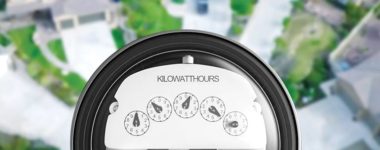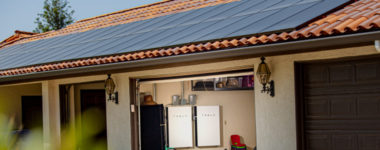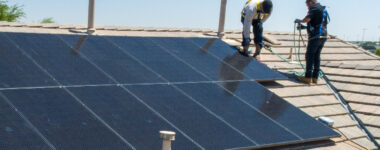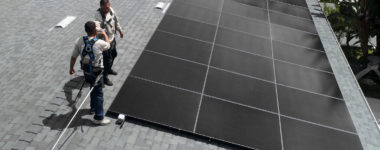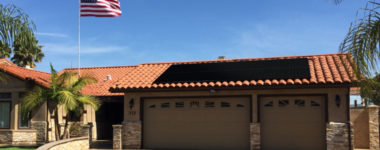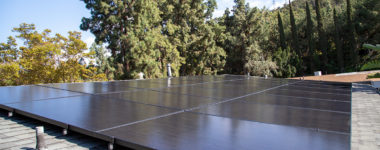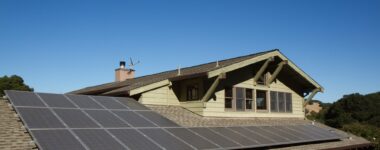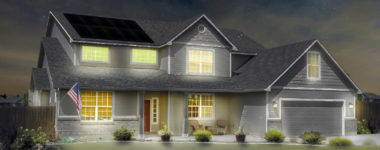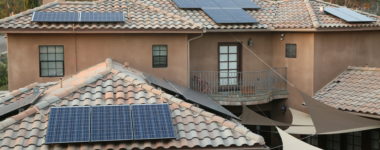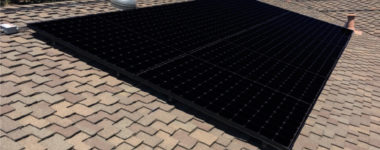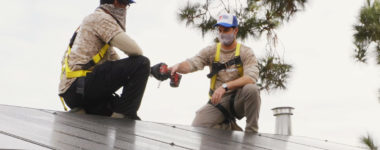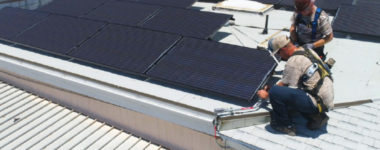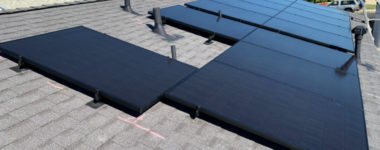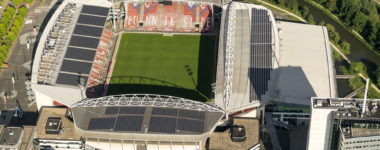Solar Panel Installation | Solar Panels, Battery Storage, Roofing, HVAC
In the summer of 2023, the average electricity bill is expected to rise five to eight percent compared to 2022. Rising costs play a significant role in the decision for many consumers to switch to solar. However, what about when you need to use energy from the power grid? Understanding time of use rates and how they work will help. What Is a Time of Use Rate? Time-of-use (TOU) rates are a type of billing system used by some utility companies to charge different prices for electricity based on the time of day. This means that during certain peak hours, when demand is high, you'll pay more for your electricity than you would during off-peak hours. How Does the Electricity Company Track What Time of Day You're Using Energy? Understanding how your electricity company tracks your energy usage throughout the day is crucial if you want to maximize your energy savings with TOU rates. Many companies use smart meters to track your energy usage. How Do TOU Rates Work? Time-of-use (TOU) rates are a pricing system offered by utility companies to encourage consumers to shift their energy consumption during peak and off-peak hours. The TOU rate structure divides the day into different periods based on customer usage patterns, typically three: on-peak, mid-peak, and off-peak. By taking advantage of lower rates during off-peak and super off-peak periods, you can avoid higher weekday rates when energy resources are in demand. What Are Peak Hours? Peak hours are the time of day when electricity demand is at the highest. With TOU programs you’ll pay the highest rate during peak hours. These hours are generally during the late afternoon and early evening when more people are at home and consuming electricity. What Are Mid-Peak Hours? When looking at pricing periods, mid-peak hours fall between peak demand and off-peak demand. During this time of day electricity rates are lower than during peak hours, but still higher than off-peak hours. What Are Off-Peak Hours? On the opposite side of things we have off-peak hours. This is the time of day it is cheapest to use electricity. Generally, off-peak hours fall during the night when most people are asleep and not actively using electricity. What Is the Cheapest Time of Day to Use Electricity? If you're wondering what the cheapest time of day to use electricity is, it depends on where you live and what your utility's peak hours are. However, in general, the cheapest time of day to use electricity is usually between 9 PM and 7 AM. So consider shifting some of your energy usage to these off-peak times to save even more money with TOU rates. Time of Use Rates and the Changing Seasons It's also important to keep in mind that time of use rates change with the season. During the summer months, when air conditioning units are running more frequently and for longer periods of time, peak hours may be adjusted accordingly. The best way to stay informed about changes in TOU rates is toregularly check with your energy provider or utility company and adjust your usage habits accordingly. More Control Over Your Electricity Costs One of the primary benefits of time-of-use (TOU) rates is that they provide consumers with more control over their electricity costs. With TOU rates, electricity prices vary based on the time of day and season, which means you can save money by shifting your usage to off-peak hours when rates are lower. Reduce Strain on the Power Grid Another advantage of TOU rates is that they help reduce strain on the electrical grid during peak hours. By encouraging people to use energy during off-peak periods, utilities can avoid building expensive new power plants or transmission lines to meet demand during peak times. Higher Energy Costs During Peak Demand One major drawback is the potential for higher electricity bills during peak hours. This means that if you consume a lot of energy during peak times, such as in the evening when everyone is using their appliances and electronics, your bill could skyrocket compared to what it would be under a flat rate plan. Confusing Pricing Structures Another issue is the complexity of TOU rates. Consumers need to understand when and how usage charges change throughout the day and adjust their habits accordingly in order to see any real savings. This can be difficult for some people who are used to simply paying a flat rate each month. Time of Use Rates and Solar Power Time-of-use (TOU) rates can have a significant impact on the economics of solar power. Because TOU rates vary based on the time of day, homeowners with solar panels may be able to take advantage of higher electricity prices during peak hours with net metering by selling excess energy back to the grid. Net Metering and Time of Use Rates With time-of-use rates in place, it’s important to pay attention to how much energy is being produced and consumed during peak hours versus off-peak hours. If too much energy is being generated and sent back to the grid during off-peak hours but not enough is available during peak hours when rates are highest, homeowners may end up paying more for their electricity, even with solar panels installed. Avoiding Peak Demand Charges With Solar Power A great way to decrease your exposure to peak pricing on time-of-use rates is to invest in solar, and even more so to invest in solar-plus-storage. If you generate and store enough energy during off-peak periods using your solar panels and an energy storage system, you can use that stored energy during peak periods instead of buying it from the grid at a higher price. Are TOU Rate Plans Right for You? The answer depends on your energy usage habits and lifestyle. If you tend to use most of your electricity during off-peak hours, then TOU rates could potentially save you money. However, if your energy usage is mainly during peak hours, then TOU rates may end up costing you more. It's important to evaluate your current energy consumption patterns before making a decision about switching to TOU rates. Time of use rates can help you save money and know how to use solar panels for optimalenergy efficiency. However, before you switch to time-based billing, you should understandall the factors. Don’t let electricity prices break the bank, start saving money by going solar with Semper Solaris. Sources https://www.cbsnews.com/news/inflation-electricity-bills-higher-summer-2023/https://news.energysage.com/understanding-time-of-use-rates/.. https://www.cnet.com/home/kitchen-and-household/yes-you-can-actually-save-money-by-using-electricity-at-these-specific-times-of-day/ .https://www.utilitydive.com/news/an-emerging-push-for-time-of-use-rates-sparks-new-debates-about-customer-an/545009/. https://www.energy.gov/femp/demand-response-and-time-variable-pricing-programs.https://www.solarreviews.com/blog/what-are-time-of-use-rates-and-when-is-electricity-cheapest.https://www.chooseenergy.com/news/article/time-use-pricing-fair-experts-weigh/.https://www.sce.com/residential/rates/Time-Of-Use-Residential-Rate-Plans.
The expansion of clean energy grows as an innovative solution to energy needs in the United States. Solar panel systems are becoming an energy source that plays a revolutionary role in meeting energy needs, which has fueled their rapid growth in the United States. According to SEIA (Solar Energy Industries Association), the solar market has not stopped growing since it doubled in 2016. Solar battery storage is playing a leading role in the advancement of solar energy. States that promote solar panels and solar battery storage will lead to an unmistakable solar industry trend. What is the last? SEIA has presented an ambitious vision for expanding clean energy in the US to the 117th US Congress. Aware that a new administration will take over in 2021, SEIA recently adjusted its vision for clean energy policies to help solar have at least 20% of generation by 2030 and accelerate the transition to a clean energy economy. SEIA, through one of its directors, announced on October 29, 2020, that Arkansas Group joins the National Solar Trade Association to strengthen solar defense in the southeast. Now the Arkansas Advanced Energy Association (AAEA) is an official state affiliate of SEIA. If you want to be part of this growth, you can participate in SEIA's Solar Goes Corporate. In this forum, buyers and suppliers of clean energy converge, designed to discuss how companies can effectively invest, acquire, and implement clean energy technologies such as solar energy and batteries' storage. The solar energy boom has brought with it the emergence of other renewable technology such as solar batteries capable of storing additional solar energy for later use. In this sense, companies like Tesla develop batteries combined with solar panels to create "solar + storage" systems for domestic and industrial use. Get an informative summary of the basics of solar + storage and SEIA's role by clicking on the following link: Solar + Storage. We invite you to read on to learn more about clean energy and determine if you should consider installing a solar plus storage system for your home. Keep in mind that the cost of solar energy has been falling across the country. Why Choose Solar + Storage? To consider why you may choose to install a Solar + Battery Storage system in your home, you must first understand how a solar PV system like the standard home works. The standard of a solar energy system includes: Solar panels, A kit to mount the panels on your ceiling, An inverter, A performance monitoring system that tracks electricity production. Solar panels concentrate energy from the sun and transform it into electricity, which passes through the inverter and is converted into energy used to power your home. By solar policy, residential solar energy systems must be connected to the electricity grid. This allows the exchange of energy. When your panels make more electricity than your home requires, the excess travels to the power grid. On the contrary, when your solar panels cannot supply your home's electricity demand, you can obtain energy from the electrical grid. Also, by solar polity, you will receive a credit on your electricity bill for helping the utility company by delivering excess power to the grid. Of needing more electricity than your solar panels can generate, you can use those credits instead of paying more for your utility. This process is known as net metering. In all this, the plus is given by the batteries. Solar politics energy storage can smooth electricity prices through arbitrage. It can also mitigate reduction risk, manage nighttime power ramps, provide black start capability, provide backup power, and more. Many solar energy companies like the California Solar Company see storage as a business growth opportunity. They see solar system owners as their allies. This is due to solar politics and to the fact that to achieve 20% of the total electricity generation that the solar industry is targeting, it relies heavily on cost-effective integration of storage. How Is The Storage Of Solar Batteries? The function of solar batteries is to store the energy produced by your solar panels for later use. According to technology, there are solar batteries that come with their inverter and offer integrated energy conversion. The storage is directly proportional; the greater your battery's capacity, the greater its electrical energy storage capacity. At Semper Solaris, a California Solar Panel installation company, they recommend always installing a solar battery as part of your solar panel system, as that allows you to store excess solar electricity in your home rather than send it back to the grid. If your solar panels make much more electricity than required, the excess energy is deposited in the battery. That will decrease the energy exchange with the grid. It will only send electricity to the grid when the battery is 100% charged, and it will only receive electricity from the grid when the battery is low. As you can see, houses with solar energy plus storage will be able to store excess energy for use when in contingency or when the sun doesn’t shine. They have the additional benefit of having short-term backup power in the event of failures in the public service network. Installing A Solar Battery In Your House Is An Opportunity? SEIA is firmly supporting the creation and improvements of an Investment Tax Credit (ITC) for energy storage; it is part of what it has submitted to Congress. Installing a solar battery is synonymous with saving money, which largely depends on solar politics and how the utility company compensates you for your solar energy. With full net metering, you typically receive credits on your electricity bill for every kilowatt-hour of electricity your solar panels produce, so you don't use them right away. However, it may not be so. The trend is for a solar battery to help improve the economy with solar panels for your home or business. Solar battery storage can help you save more, as long as your solar energy supplies your electricity demand. But if the utility company has times of use rates or demand charges or simply does not offer net metering. Not only that, Solar Panels and Battery Storage can help with Sleep Apnea and CPAP Machines even when the electricity goes out. How Does Solar Grid Storage Fit Into The Broader Electrical Ecosystem? Solar batteries and other energy storage technologies are set to become a market of around $ 2.5 billion in the United States by 2020-2021. Why is Energy Storage Expected to Grow so Fast? For the benefits that solar battery storage offer to their owners, such as those of homes, that is: Renewable electricity storage capacity for later use, Ease of application on a larger scale for the entire electrical network. Depending on the technology, they provide more flexibility in the generation and use of electricity, mainly from solar and wind energy. Utilities have a complex task. They need to provide their customers with a reliable and quality service. To do this, they must ensure that they have enough electricity on the grid to meet demand. Otherwise, there can be fluctuations in service and even have dissatisfied customers from experiencing blackouts. For increasing solar battery storage, incentives are needed in that direction. This will help network and utility operators manage their electricity flow operations from renewable resources with more flexibility. In the long term, it means there will be more renewable energy resources built into our nation's electricity mix, where home solar panel systems will be a major stronghold.
Originally published May 24th 2018. Updated January 6th 2021 to reflect changes to the Federal Tax Credit. Is it feeling a little hot in here? Perhaps it’s because the summer months are quickly approaching, or maybe you just opened up your electricity bill. There are so many wonderful reasons that California is a great place to build a home, but cost of living isn’t one of them. In fact, we have the seventh-highest energy rates in the whole country! As temperatures creep up and air conditioners start humming across the Golden State, electric bills can start creeping up as well. Solar panel installation is a great way to lower your energy bill (and decrease your carbon footprint), but what are some other ways to cool your energy usage and save? Let’s take a look at some easy-to-implement options. Solar Panel Installation We are a solar panel company, so it shouldn’t be too surprising that we think solar panels offer you a great solution to lowering or eliminating your electric bill altogether. Buying Solar Panels for Your House If you choose to purchase solar panels out-of-pocket, you’ll be making a significant upfront investment, but it will pay off. According to Energy Sage, the average 6 KW (kilowatt) system will cost California residents $11,928 to $15,204 when they take advantage of the federal government’s generous 26% tax rebate (which, unfortunately, won’t last much longer). A 6 KW solar panel system is one of the most common sizes we install, and it covers the energy needs of a typical, mid-sized home. Buying solar panels for your house isn’t cheap, but the average system pays itself off in seven years. When you keep in mind that solar panels are estimated to last anywhere from 25 to 40 years, you can see the potential for big savings down the road, especially because the panels themselves add value to your home! It’s estimated that over 20 years of life, solar panels can save the average homeowner in Los Angeles $50,000! Solar Leases and Power Purchase Agreements Of course, not everyone has $12,000 sitting in their bank account. California residents can still save on electricity by choosing a solar panel lease or a Power Purchase Agreement (PPA). Both of these options offer no upfront payment. Instead, the solar panel installation company owns the solar panels and charges homeowners a set rate for the energy they use, which is less than what they would pay the electric company. The beauty of this system is that as energy rates increase (and they always do), homeowners with a solar lease or PPA will increase their savings. Whether you purchase solar panels or choose a solar lease or PPA, you’ll still want to keep your energy usage as low as possible during the long, hot California summer. If you use more energy than the solar power system for your home was designed to produce, you could still end up paying big bucks to the utility companies. Here are some other tips to lower your energy usage during summer. Save on Air Conditioning Nothing feels better on a scorching day than the sweet whisper of cool air pouring through the vents when your air conditioner kicks on. However, your air conditioner also happens to be an energy hog! The typical air conditioner guzzles 15,000 watts of electricity per hour. Compare that to the average desktop computer, which hums along just fine on 400 watts per hour. California charges on average $0.15 per kilowatt, meaning your air conditioning will set you back an average of $2.25 for every hour it’s on. If it’s running six hours a day, you’ll be paying $94.50 every week! That doesn’t mean you need to unplug your air conditioner for good and resign yourself to the fact that your home will morph into a sweat lodge for the next few months. Instead, there are a few simple things you can do to reign in the costs. Change Your Air Conditioning Filter You do know that you’re supposed to change out the filter on your air conditioner every three months, right? Filters are cheap (usually less than $10 each) and can improve the efficiency of your air conditioner. New filters can also make your home cleaner by filtering out dust and other outdoor irritants. Increase Your Air Conditioning Temperature In a perfect world, you’d put your air conditioning on the minute the temperature ticked up to 72 degrees, but let’s be honest. You can probably survive just fine without air conditioning for another two or three degrees, right? If you can cut the amount of time you use your air conditioning just one hour each day by setting your air conditioning on a higher temperature, the average Californian could save nearly $70 a month! Don’t Cool Empty Rooms If you’re the only one in the house, or you and your family are heading to bed, close the vents in the other rooms. There’s no need for your air conditioner to cool off your microwave in the kitchen or your couch in the living room! Use a Fan Another smart idea is to take advantage of a fan, which uses much less energy. If you have a ceiling fan, turn it on. You might be surprised how just getting a nice breeze can help you feel much cooler. If you don’t have a ceiling fan, invest in a floor fan or even a desktop fan. This option is especially good if you are home alone and don’t want to go through the hassle of closing all the vents. Now you can keep the temperature in your room comfortable without having to turn on the air conditioning to cool the entire house! A Few Other Cost-Saving Tips Making the changes above to how you use your air conditioner can help you save on electricity costs in the summer, but that’s not all you can do. Here are a few more quick tips that you can use to cut your energy usage all year round. Play the Variable Price Game Some utility companies throughout California have been rolling out “variable pricing,” which increases the cost of electricity during certain set times of the day when demand is the highest. Find out if you have a variable price plan and then determine which time periods will cost you the most. It shouldn’t be too hard to run the dishwasher or the washer and dryer outside of those hours. Limit Your Hungriest Power Users Your air conditioning unit isn’t the only device in your home that loves to gobble up electricity. Your washer and dryer use 4,000 watts per hour and your water pump uses 3,000 watts per hour. So make sure you fill up the washer with each load. If you have half a load ready to go, see if you can double up with one of your family members. (Just don’t let them talk you into folding all their socks and underwear too!) Also, if you have a heated pool or jacuzzi that you only use on the weekends, pull the plug during the week. If no one’s using it, don’t spend energy and money on it! Turn Off the Lights Let the long hours of daylight give you all the illumination you need for as long as the sun is up. Lightbulbs, especially the energy-efficient LED bulbs that most of us use, only sip small amounts of energy, but it can still add up. According to Spark Energy, 10 lightbulbs running for six hours a day will cost you $120 a year. That’s not exactly a king’s ransom, but we bet you can find a lot of better ways to use that money. Plus, lowering your energy bill is only part of the benefit of using less energy. By flipping off your light switch, you can also lower the amount of carbon you contribute to the environment. It’s Time to Save There are all sorts of ways that you can cut your energy usage this summer and save on your electric bill. Some tips are as easy as flicking off a light switch in an unoccupied room or running the dishwasher an hour later. Others will require a bigger investment, like solar panel installation, which will pay off big in the end. Every step you take to cut power is a step in the right direction to lower your energy bills and to be a little more energy wise. We hope that you and your family have an amazing summer! And if now is the time for you to invest in solar power for your home, please give us a call to schedule a free energy analysis.
The United States Energy Policy Act of 2005 established the Investment Tax Credit or ITC for short. In regards to solar power installation, this meant a homeowner that owned their solar system free and clear would receive a federal tax break for the total cost of their solar investment. As solar is rapidly becoming ever more popular, the incentive is set to decline over the upcoming years gradually, so if you have been considering solar, now is the time to act. The federal solar tax credit for 2022, also known as the investment tax credit (ITC), deducts 30% of your solar panel installation costs from your federal taxes. This tax credit is subject to change. NUMEROUS BENEFITS OF SOLAR The 2022 ITC is not the only reason to research and evaluate the many benefits of alternative energy sources for your home or office. Solar is an environmentally friendly, renewable, and sustainable energy source that has the capability of fully powering your residence or commercial space, precisely as a traditional “grid-based” power company would, For greater than half the cost of grid electricity. In an area prone to fire-prevention power outages or a grid circuit that has potential for brownouts? Solar power can provide other benefits such as reserve power systems, which are units that store the acquired solar energy - all while still powering your home - for use in an emergency. It sure would be nice to be able to turn the lights on or leave the air conditioner running during times of no power. SIGNIFICANT FINANCIAL SAVINGS The aforementioned “grid” companies such as Southern California Edison charge upwards of ¢25 per kilowatt-hour (kWh), while solar power costs are as little as ¢.06 per kWh. If the average household uses in the neighborhood of 900 kWh per month, then solar energy provides an approximate yearly savings of $2,000 over grid-based electricity! That is a substantial difference, especially in the higher cost of living areas where saving money is essential. The average size residential solar power system is 6kW, which is an approximate $19,000 upfront cost. These credits greatly help absorb the initial cost, as well as get you closer to full fiscal recuperation of the system faster. After taking your ITC, and saving $2,000 in electricity usage costs in the first year, you’ve already made a $19,000 solar system and paid only $10,000. If you choose to remain in your solar-powered home, the system will entirely pay for itself only five to ten years later. Choosing to sell your home? The average home in California will sell for $20,000 more with solar installed!
Solar panels have many advantages, and saving money is definitely one of them. Using solar energy in place of grid electricity can save money on the monthly electricity bills. Though solar panel installation is quite an investment, the overall benefit offsets the one-time high investment. If you plan to stay in the same house for long enough, you can quickly recoup the investment on solar power panels in a few years. Moreover, with battery storage, you can save the extra electricity generated by your solar panels and use it in place of regular grid power. Semper Solaris is a Tesla Powerwall Certified Installer, so you can be sure that you will have a top-of-the-line battery installed! Now, most utilities allow consumers to sell solar power to them. Either way, you can save money through the power generated by the solar panels installed on your property. Solar power also saves you money when the electricity goes off for a more extended period, such as during a storm or forest fire. The solar energy not only supplies power to your house and allows it to function without any significant disruption. It also does so for no extra cost. If you use a generator, it will consume fuel, cost you and cause noise and pollution while the solar power will provide you power without any extra cost. Clean energy A primary reason why solar power is popular is that it is clean and renewable energy. Unlike fossil fuels, it does not generate pollution. Its mechanism allows it to tap solar energy without creating any pollution at all. So, when you are using a water heater, illuminating your house or running the appliances on solar energy, you know the power has a completely clean source. Another important aspect of solar energy is that it comes from a renewable source of energy. Unlike coal, petrol, or gas, solar power is not going to get depleted with time or overconsumption. Adding solar power to the sources of power that we use can ensure energy security. Considering the pollution that fossil fuel generates and the entire spectrum of problems that pollution causes, solar power is a lot more beneficial and cost-effective. Solar installation Why some people think solar panels may not be saving money for its consumers is because of the significant investment that it entails at the time of solar installation. Setting up a solar power system is somewhat cost-intensive. You have to invest in solar panels and possibly batteries depending on your preference. But once the investments are made, you can reliably tap into solar energy and save on the electricity bills. Except for minor repairs from time to time, changing the batteries is the only recurring cost associated with solar energy. The Final Answer Although installing a solar energy system at your property may look like an expensive proposition, the long-term savings that you make on the monthly electricity bills far outweigh the one-time investment. More importantly, in the case of solar energy, you are using a clean source of energy that’s not adding to the pollution.
The first thought you may have is, ‘Well, my roof is big enough, I’m good to go.’ Sadly, that train of thought is a recipe for disaster. So, what other things should be considered beforehand? How much energy do you currently consume? Do you have proper insulation - as in, are your heating and cooling systems efficient? Have you installed high-efficiency lighting (LED/CFL) where you can? Do you set your thermostat to average temperatures, like 72F? All these questions need to be asked and answered as well as other factors, such as which way your roof predominantly faces, its size, and how many average days of sunshine your area has. Those above all affect how many panels you need. [embed]https://youtu.be/x57pqrLdIog[/embed] YOUR SOLAR ENERGY POTENTIAL ow that you have ensured your home is as energy efficient as possible, you need to decide your home’s solar energy potential. Several websiteswill help you map your home’s potential. For the most efficient use of a solar system, your roof should face the south. However, there are other caveats to consider that will affect the efficiency of your system. What is the area of your roof? Does your HOA, landlord, or county ordinance allow for the installation of solar panels? How many average days of sunshine are there in your area? There is a common misconception for homes in an area with frequent severe and/or cloudy weather that solar energy is unavailable. The truth is, solar energy is most definitely available - but more panels may be needed - or an energy storage system such as a battery storage unit that will store solar power via a rechargeable battery system. This system will automatically turn itself on if there is not enough active solar energy available. WHY NOT FACE THE ROOF IN THE DIRECTION OF THE SUN? When I first started learning about solar, I automatically assumed the best direction for a roof to face for solar was west, to gather all the high energy rays from noon until dark. However, westerly facing solar roofs provide one major issue - they do not receive near enough energy in the morning hours. The solution? Southerly facing solar panels. A roof with high exposure to the south will provide the most considerable amount of time with solar absorption on any given *sunny* day. A little trivia: In the southern hemisphere, this is opposite - solar panels go on the north-facing roof. As with anything, there can be exceptions to the rule. Depending on your reasoning for solar, in rare cases, it may benefit you to have your panels face west. For instance, if trying to avoid peak use charges on grid power, a western exposure may help you more than southern exposure, as your home and panels will be receiving the maximum kilowatt-hour (kWh) during these times (late afternoon - dark). No matter what, the best thing to do is to hire a professional roofing company to handle the installation. WRAPPING UP If you are considering solar energy for your home, be sure to bring in a professional to assess your home and discuss with you your needs. Make sure your HOA and county ordinance allows for the installation of solar panels on your roof - before your consultant arrives. Also, it is best for all named title parties to be present during the consultation. Now that you’ve had your consultation sit back, relax, and enjoy paying pennies on the dollar in comparison to what you once paid for electricity.
HOW LONG DO SOLAR PANELS LAST? You’re interested in solar power for your home or office; now what? First things first: solar panels, like any product, do indeed degrade over time. This means there will be a reduction in energy efficiency from year-to-year. The good news is that the enhancements in solar technology over the last decade have provided a much better product. What does that mean for you, the consumer? It means the latest solar panels decline at a rate of about .5% per year. In layman’s terms, if your brand new solar panels are operating at 100% efficiency upon installation, then they will perform at 99.5% efficiency after one year of use, and 90.0% efficiency after 20 years. A vast majority of the solar power industry provides a warranty of excellent length for their product - most often between 25 and 30 years. Investing thousands of dollars will always be a reasonable cause for concern. Still, the solar power industry wants to bring its customers the greatest peace of mind possible, and they do this by backing their products. While your solar panel warranty may expire after 25 years, chances are excellent, your solar panels will still be very efficient for many years to come. SOLAR PANEL ENERGY PAYBACK TIME (EPBT) Like millions of us in the world today, energy and resource conservation has become a huge talking point. Naturally, we want our beautiful planet, with its limited resources, to last as long as possible, so many generations from now, there will still be resources aplenty. The solar power industry has come up with a measurement standard, known as Energy Payback Time, or EPBT, due to the concerns on climate change, reduction in waste product, energy consumption, and things of the ilk. What is EPBT? A concern of solar energy for many consumers is the potential for environmental damage during the manufacturing of the panels themselves. In other words, are you damaging the environment more than you’re going to help it? Absolutely not. So how long does it take to recuperate the energy spent to produce the panels by your usage of the clean, renewable, sustainable energy our closest star provides? Surprisingly, newer, high-efficiency solar panels pay back their ‘debt’ in only six months. WHAT ARE THE EFFECTS OF SEVERE WEATHER ON MY PANELS? After investing thousands of dollars into your solar panels, one of your most significant concerns may be the effect severe weather will have on your system. Believe it or not, the United States Government actually has a hand in industry standards that are set for solar panel durability via the Solar Energy Technologies Office (SETO). Over the years, SETO has developed a series of tests that provide consumer confidence in solar energy investments. In 2017, there was a significant hailstorm in Denver, Colorado, that produced hail THREE inches in diameter at the National Renewable Energy Laboratory (NREL). The Denver NREL has 3,000 solar modules, and after the hailstorm, only one panel had been damaged! PEACE OF MIND Rest easy, you have peace of mind. Your panels will survive severe weather, you are helping the environment by using renewable energy, and you have a warranty that may outlast the mortgage on your home. Solar power is the way of the future. Jump on board!
Solar panels are a significant investment, but you may be wondering… What about when it’s dark? Do my panels still work? Well, the easy answer is no. Solar panels are made from a photovoltaic material that needs sunlight to produce energy, so when it is dark, the panels do not produce power. However, that doesn’t mean you will be left out in the dark! Your solar panels go into standby mode, and you draw power from the grid instead. Here are a few ways you can still keep your home up and running during the evening hours Net metering: This term means that during the day while your panels are producing excess power, that extra is sent back to the grid, and you earn credits. At night, you can draw those credits back to use instead of paying for power from the grid. You will have to check with your local power company to see if net metering is available in your area, or give Semper Solaris a call. Some power companies are phasing out net metering, or they charge a higher rate for you to use those credits. What if my company doesn’t have net metering or if I use all of my credits up? In the evening, when your panels go into standby mode, you will draw power from the grid-like you usually would. You will receive a bill for your usage just like you do now, but it will be a smaller bill than usual because your panels provided your home with electricity during the day. Battery Backup System: Investing in batteries is a great way to store your own power, so you do not have to rely on net metering or the grid at all. When your panels are producing more energy than you can use during the day, the excess is channeled to a bank of batteries. At night, your system will switch to battery power, and you can use your stored solar energy to keep your home up and running free from the grid! You can also rely on your batteries during blackouts or other types of power outages. What about cloudy or rainy days? Well, luckily, your panels still produce some power even when there is no direct sunlight. In fact, sometimes your panels provide more energy during cloudy days because the sunlight reflects on the clouds, which can produce more power than the sun alone. Generally, on a cloudy or rainy day, though, your panels will provide 10-25% of what they usually would, so you may have to rely on the grid for power unless you have a battery backup system. Give us a call if you would like to learn more about installing a battery backup system with your solar panels. We can evaluate your current panels to see if we can add batteries, or if you do not have solar and want to install both at the same time, we can help!
Step By Step Guide To Installing Solar Panels Are you getting serious about going solar? If so, you may be wondering about a few things. How does installing solar panels work? Who installs solar panels? How long does it take? What are the pros and cons? It is helpful to understand the solar installation process so you can check all the boxes on your new adventure into solar energy for your home. 1. Find the Right Solar Company Once you have decided that you do want to switch to solar, the first thing you need to do is find the right solar installer. There are so many of us out there it may seem overwhelming. Get started on the right footing by finding a local solar company with an excellent reputation. Strong reputation in the solar industry History of excellent customer satisfaction and reviews Experience in every aspect of solar installation All business and trade licenses for contracting, electrical, and home improvement North American Board of Certified Energy Practitioners Certification (NABC) Semper Solaris is the right company with years of experience in the installation of solar panels. We have a solid reputation in the solar industry built on trust and excellent customer satisfaction. 2. Initial Site Evaluation and Signing of Contract Once you have chosen a solar company, a representative will come out and do the initial inspection of your home. They will evaluate the property and take measurements and discuss the options with you. They will show you how much you will save and offer rebates, incentives, and solar financing opportunities so you can make a firm decision whether to invest in solar panels. Once you are satisfied that you have the right solar company, you will sign a contract, and the installation process will begin. 3. In-depth Site Assessment The site assessment is a more comprehensive evaluation of your home for your solar system. An engineer or technician from your solar company will come out and assess various aspects of your home for solar installation Will your roof support the panels? What is the direction of the roof? Where is the best exposure to sunlight? Is the electrical box is compatible with the system? Is a roof or ground-mounted system better for your property? Semper Solaris is the best solar contractor for answers to those questions. We have answered them hundreds of times, and we will get you up and running with solar in no time. 4. Paperwork, paperwork, paperwork Your solar company will handle most of the paperwork and apply for permits with the city. You will need to complete building permits, rebates, incentives, and financing arrangements before work can begin on your solar panel system. The permitting process will take from 30 to 90 days. Your installer should be experienced with your city’s procedures and will handle the permits through to final approval. The local permitting agency will review the permit applications for compliance with state and local requirements for safety. Structural safety Electrical safety Planning and Zoning Fire Safety Once your project receives the permitting approval of your system design, your installer will order the equipment and set a date for beginning the installation. The installation will take a few days. Once your solar contractor has installed all the panels and the wiring, he will install the inverter, so the DC is converted to AC. 5. The Final Steps in Going Solar Now it is time to connect to the electrical grid. In this last phase, the city planning and utility company will come to inspect your solar installation Does the system meet all regulations? Is the system installed correctly? Are the connections attached correctly? Are the electrical systems working properly 6. Final Approval And now the moment you have been waiting for! With a flip of the switch, your solar power is buzzing on the roof. Congratulations! You are the proud owner of a fantastic innovation of modern technology—you have harnessed the sun— you have taken a step towards energy independence –you have reduced your carbon footprint—it is all savings from here on out. Semper Solaris is the best solar company to flip the switch on your new solar panels. From the planning to the permitting to final approval, we will be there every step of the way to see that your solar power system is the best it can be.
There are several factors to consider when evaluating solar panels and equipment, including manufacturing, durability, and quality. Identifying the best solar panels is determined by how effective the panels are at converting sunlight into electricity. And aside from the manufacturing of panels, some factors can influence the effectiveness of solar panel installations. Location Climate Shading Size of roof Experience of the installer The knowledge and the experience of the installer are critical in achieving the highest efficiency and functioning of solar panels. Semper Solaris technicians know how to achieve the best performance while offering only top-rated solar panels and equipment. We will design your solar panel system for optimum performance. How Do Solar Panels Produce Electricity? Solar panels are a system of photovoltaic cells linked with metal frames and wiring and connected to your home’s electrical system. The solar cells in each panel transform sunlight into DC power, which is circulated through the panels and into a solar inverter. The inverter converts the DC power into AC Power, electricity for your home. Semper Solaris knows how solar works; we offer the highest quality products and expert installation. We have various options for panels and inverters from the most reliable solar panel manufacturers. How are solar panels rated? Solar panels are rated for power output and efficiency. Most solar panels have power ratings of 200 to 300 watts, the higher the power rating, the more efficient the panels are at converting sunlight into energy. This rating is an excellent way to compare solar panels. Other issues like power tolerance can influence energy production. Semper Solaris understands the power output of solar panels, and we offer only the top-rated solar panels from the most reliable solar manufacturers. Solar Cell Efficiency The number of cells in each pane is directly related to the amount of energy the solar panels create. The cells are made with a semiconductor material such as silicon, which is the most common material used. The efficiency of the solar cell structure is a critical consideration when rating solar panels. The efficiency rating indicates how effective a solar panel is at converting sunlight into electricity. Most solar panels have a rating of around 23%. The higher the score, the more power the panel can generate. Semper Solaris is experienced and knowledgeable in assessing a home for the right panels with ratings that will operate at maximum efficiency. Solar Panel Quality Solar panels are tested for their strength and reliability in real-world simulations. A high-quality panel will carry at least a 25-year warranty from the manufacturer both on material and power production. Durability Reliability IEC 61215 reliability standard Snow and wind load Top-rated Manufacturer’s Warranty The best solar panels are American made. They have proven to be the most reliable, efficient, and superior in design and construction. Semper Solaris offers solar panels that are both high quality and economical for budget-minded homeowners. We stand behind each and every solar panel system we install. Contact Semper Solaris today and schedule an evaluation of your home for your solar power installation.
When you have decided to install solar panels on the roof of your home, then you will have to consider several things before installing solar panels, including solar panel maintenance, types of solar panels, etc. Asking the right questions is essential when installing solar panels. Here's a list of what questions you need to ask to make sure you cover all your bases. Questions to consider when wanting to install solar panels Is the type and shape of your roof right for installing solar panels? This question will allow you to know the suitability of the type and shape of your roof in this regard. Usually, you can find roofs with slopes on its two sides, which meet at a point on the top. But you can also find roofs in various sizes and shapes in the US, including mono-pitched shed, curved, lean-to, mansard, flat, dormer, hip or pyramid, etc. Whatever the type of roof, the critical thing to consider is which roofing company to hire. Also, you need to provide enough space to install the solar panels and must get enough sunlight. Can your roof support solar panels? The next important thing to consider before installing solar panels is the support provided by your roof to them. It will allow you to know whether your roof needs to be replaced or repaired if it is old or damaged. So, before installing panels, it is better to fix the defects of your roof so that it can support the panels properly. It is necessary to make your roof structurally strong as it has the bear the weight of the solar panels also. How energy efficient is your home? Along with ensuring the condition of your roof, you should also focus on whether your home is energy efficient or not. You can quickly improve the energy efficiency of your home in an affordable manner before installing solar panels. If you have improperly sealed doors and windows, old HVAC system or insulation this would qualify as insufficient. It will allow you to install a smaller solar panel as your energy consumption will be reduced. What about warranties? Many companies offer different types of warranties to ensure the quality of their solar panels. You must know the cover provided by the warranty so that you should not spend any more on them if anything happens to them throughout their life. These warranties can vary by manufacturer, but they usually cover the performance of the equipment produced by them. Which direction is the slope of the face of your roof? The slope of the face of your roof should be in the direction of the sun so that it can absorb as much energy as it can from the sunlight falling on the solar panels installed on it. Your panels will not be able to produce maximum solar power if the slope of your roof is not sun-facing. It is essential to place the solar panels on a south-facing surface of the roof to get the best results. You can also install solar panels on your roof if some of its parts are west facing. Sometimes, the north or east-facing surface of the roof can also be used for installing solar panels depending on its azimuth and pitch.
Solar panels are the best sustainable source to save energy. Solar energy, being one of the largest renewable sources of energy, can be converted for electricity as well as other sources of power in the household. Solar panel installation in one’s home is undoubtedly cheap, which provides an unlimited source of energy. Still, it does require a minimum amount of care for it to function correctly for long terms. Why Care for Solar Panels? In general and simple words, solar panels are generally glasses that are systematically installed in one’s household to absorb the solar light. The more solar light this tool absorbs, the more it converts that light into forms of energy and store in it a battery. But since the solar panels are always installed in open spaces, they are prone to some external damage. These damages are not really serious but are external forces that obstruct the glass surface and stop it from absorbing the sunlight to its fullest extent. These external forces can include dust, dirt, and spots because of water in the atmosphere, rain, bird droppings, or cracks because of hail or some other objects and much more. These factors might look like issues that can be overlooked, but in reality, it obstructs the solar panels from functioning correctly, therefore, solar maintenance is an absolute necessity. Solar Panel Care Guide It might sound hard to accept, but the only time one cares for their solar panels are during the times when something damages it really bad, or the tool completely stops functioning. This increases the cost of solar panel maintenance, moreover, gives extra headaches since several appliances might work with the support of solar panels. Therefore, it is of utmost importance to care about one’s solar panels, and it should be done as regularly as possible. According to every solar contractor in the market, it is highly advisable to check one’s solar panels at least once in 6 months. This period is an ideal gap for regular solar panel care since the weather changes every 3-4 months, and a solar panel can adjust that much of change or damage. Moreover, it is not just the glasses that need care and has to be checked. Instead, the screws and hinges also need enough checks and care as they are always at a risk of getting loose or rusting due to environmental factors. Another thing to consider for solar care is to continually check the solar batteries that are connected to the panels. This battery is highly complex, and a regular checkup saves it from complete damage since it is one of the vital parts of the whole solar panel system. Other than this, regular checkup of solar batteries protects the entire house from significant risks, like that of fire, since it converts and transfers electrical energy into the household. At-home care and regular checking of the solar panels can be done by the individual itself. Still, it is usually advisable to call a solar contractor for professional support or if you are not comfortable enough to get on your roof to do the maintenance.
The Capital city of Sacramento is the hub of California’s objective to reduce greenhouse gas emissions and dependence on fossil fuels. With the seven climate change pillars pointing the way, California is the leader in the development of renewable energy. The Pillars are an aggressive plan for cutting fossil fuels and achieving the goal of 50 percent renewable energy by 2030. If the saying is true that there is nothing new under the sun, then harnessing the power of the sun is nothing new. And we have the technology to utilize it and make it a viable energy source. It is a TechnoNatural phenomenon that solar technology converts sunlight to energy, and much like the process of photosynthesis transforms that energy into electricity to power our homes. Semper Solaris is the best solar company in Sacramento for installing solar for your home. We are at the forefront of promoting technology and innovation that is changing the way the world works. Whether it is lowering your carbon footprint or pollution or any other problem solar solves, solar is the energy with the future in mind. Looking to Solar Power The goal of achieving 50 percent of energy from renewable sources is a worthy goal. The reach of solar power in Sacramento goes beyond the purposes of California. Solar power is the most cost-effective and efficient energy source for solving a variety of problems at home and in the world. The cost of producing solar power when you compare it to fossil fuels is meager. Unlike fossil fuel power plants, solar power leaves no toxic waste in the air, water, or land. Solar energy is portable and can be dispatched quickly and easily. Solar power reduces air pollution Solar as an energy source improves water quality Protecting the environment protects your health Solar energy is a key player in fighting poverty. Solar power is helping the homeless. Solar provides power in emergencies and disasters. With credentials like these, solar power holds first place as the power source for the betterment of the world. It makes sense for homeowners to switch to solar power in Sacramento as the model city for clean and renewable energy for the future. WHY SOLAR IS THE BEST ENERGY ALTERNATIVE Future technology will increase the demand for more and more electricity to run our smart homes, appliances, and equipment. Cars with EV stations will be the new normal in the not too distant future. Our smart homes are about to become more intelligent and will need more energy. Solar power is, by far, the most economical and most straightforward way to deliver more electrical power efficiently. Solar power can answer the need for more energy. Solar can help solve big problems in the world. Solar power is the energy source for the future. Solar power is cost-effective, Solar power is sustainable We at Semper Solaris believe that solar energy is the best alternative to fossil fuels. Solar can provide exponentially more electricity without a negative impact on the environment. We are on the frontlines of renewable energy technology and innovation. Call Semper Solaris today if you don’t yet have a solar panel installation in your Sacramento home. Now is the perfect time to join the future of renewable solar energy. Help solve world problems starting in your town, in your home.
There’s nothing like watching your favorite sports stars sweat it out as they run, swing, kick, or dribble their way to glory. What you might not realize is that those lights could be powered by solar panels. In fact, many of today’s latest and greatest stadiums are joining the clean energy revolution by incorporating solar into their design. This environmental commitment makes a huge difference, not only because it lowers the carbon footprint of an energy-hungry stadium. Sports stadiums and facilities that adopt solar panels can also help normalize renewable energy and help make clean energy as American as apple pie and baseball! Under the Bright Lights – Sports Stadiums Are Embracing Solar Panels If you’re fortunate enough to snag tickets to a San Francisco 49ers game, you’ll get to join 68,500 of your fellow ‘Niners at Levi’s Stadium to cheer your heart out. It takes a tremendous amount of power to run the stadium, which spreads across 1.85 million square feet. Fortunately, the builders of the stadium made a commitment to clean energy. Keep your eyes open, and you might notice that the bridge you cross to get from the parking lot to the stadium incorporates hundreds of solar panels. Levi’s Stadium is only one example of how sports arenas across the country have come to embrace renewable energy as well as policies to reduce water usage and waste. The Solar Energy Industries Association found that sports facilities across the United States have collectively built up a capacity to generate 46 megawatts (MW) in renewable energy. That’s enough energy to power 8,000 homes. Additionally, The SEIA report noted that almost half of this capacity came online in just the past three years. This implies that the rate of solar adoption is accelerating. Soon enough, every new stadium in the United States may be powered by the sun. Is your favorite team playing in a solar-powered stadium? The SEIA reports that in 2017, more than 42 million Americans attended an event at a sports facility that received energy from solar panels. Unsurprisingly, California’s sports teams lead the solar sports pack. Here are just a few famous stadiums from California and beyond that run (at least partially) on solar. Find out if your team’s stadium made our list. Solar Powered Baseball Stadiums We have to start with America’s pastime. Baseball has been with us since 1869, but that doesn’t mean its stuck in the past. Today’s baseball stadiums are equipped with dazzling electronic scoreboards and glittering lights. That energy has to come from somewhere. In a growing number of cases, the lights showcasing that amazing grand slam are powered by solar energy. Chase Field – Arizona Diamondbacks Arizona may be infamous for its heat, but a sweltering day doesn’t scare off a dedicated D-Backs fan. Arizona is also famous for something else – lots and lots of sunshine. In a masterstroke, the builders of Chase Field built a 75-kWh (kilowatt hour) solar pavilion just outside the ballpark’s western entrances. D-Backs fans can catch some delicious shade while the pavilion overhead helps keep the lights on inside the stadium. The Chase Field solar pavilion is only one part of the stadium’s commitment to going green. A member of the Green Sports Alliance, Chase Field also features a vertical urban garden, chilled water loop air condition systems, and concession uniforms made from recycled plastic. In 2016, the stadium was able to donate 12,290 pounds of unused food. Safeco Field – Seattle Mariners Seattle isn’t exactly known for its copious amounts of sunlight, but as we’ve mentioned before, solar panels can still work on overcast and cloudy days. Safeco Field puts this theory to the test with its impressive 33-kWh solar system, which generates 40,000-kilowatt hours of electricity each year. That’s enough energy to offset 28 metric tons of CO2 emissions. Sadly, it might not be enough to power the Mariners to the playoffs this year! Solar-Powered Football Stadiums Baseball may be “America’s pastime,” but come Sunday, it’s all about the pigskin and the touchdown. While football has a reputation for appealing to our more basic instincts, you may be surprised to learn that it is leading the sports world when it comes to renewable energy. In fact, a full third of NFL teams play or train in stadiums that incorporate solar panels. Here are just a few. Levi’s Stadium – San Francisco 49ers 49ers fans should be proud of their stadium, which opened in 2014. Levi’s stadium is huge, gorgeous, and one of the most environmentally friendly stadiums in the country. Not only does it boast over 1,000 solar panels, which generates enough energy to power all of its home games, but it also irrigates its fields with mostly reclaimed water and has a beautiful, 27,000 square foot “green roof.” No wonder Levi’s was the very first stadium to earn a gold LEED certification (Leadership in Energy and Environmental Design) from the US Green Building Council (USGBC). Mercedes-Benz Stadium – Atlanta Falcons The Atlanta Falcons may have seen their Super Bowl LI dreams crushed in a heartbreaking overtime loss in 2017, but perhaps they can take a small amount of solace in one thing. Their Mercedes-Benz Stadium, which opened the year after their Super Bowl defeat, incorporates a 1,300 kWh solar panel system. To churn out this much power, Mercedes-Benz Stadium needs the help of over 4,000 solar panels, which it uses to power both its stadium and nearby neighborhoods. Maybe that will make up for all the Sunday traffic it creates! Lincoln Field Financial – Philadelphia Eagles If you needed one more reason to love the Philadelphia Eagles besides the fact that they beat the Patriots in Super Bowl LII last season, we’ve got it for you. Not only are the Eagles our current Super Bowl champions, but they are also solar champions. Lincoln Financial Field’s 11,000-kWh solar system installation has a capacity to generate a staggering 3,000 kWh of energy. That also makes it the largest solar panel system in the entire city of Philadelphia. Lincoln Financial Field has already snagged a silver LEED certification, but silver isn’t good enough for these champions. The stadium is currently pursuing a gold-level LEED certification. Solar-Powered Basketball Arenas Basketball tends to take a backseat to football in the American sports lexicon, but not when it comes to solar powered stadiums. The top basketball stadiums are outplaying and outshining all the rest. We bet you’ll never guess where the top solar-powered basketball stadiums are located. Oracle Arena – Golden State Warriors Okay, so technically, Oracle Arena doesn’t have solar panels, but we’ll give this mention to the Golden State Warriors anyway because they did put over 500 solar panels on their practice facility in downtown Oakland. This 164-kWh system was installed in 2010, making it the first solar panel installation at an NBA practice facility and one of the earliest solar systems at any sports facility. Golden 1 Center – Sacramento Kings If you’re ever at a trivia competition and have to name the sports facility with the greatest solar capacity in the United States, just think Golden, like the sun. The Golden 1 Center, home to the Sacramento Kings, is officially the “greenest” arena in the country, boasting a solar capacity of 11,000 kWh. It was also the first indoor arena ever to receive the coveted platinum LEED certification. In response to the certification, Governor Jerry Brown said, “California has more green buildings than any other state in the nation, and Sacramento’s new arena is an example of the elegant design and construction we need to meet our ambitious climate goals.” While the Kings had a dismal season last year, they’re still the country’s solar sports champions! Solar in the Other Major Sports We wish we could list all the solar-powered stadiums for all the sports in our country, but you don’t have time for that. So, let’s wrap up this article with a quick look at a few more environmentally forward arenas across a range of sports. Staples Center – LA Kings, LA Lakers, LA Clippers, LA Sparks Staples Center pulls quadruple sports duty, playing host to four professional sports team, including the LA Kings hockey team, and 3 LA Basketball franchises (LA Sparks of the WNBA). That’s a lot of energy to spend on lights, concession stands, and Zamboni machines. Fortunately, Staples Center gets a little help from almost 2,000 solar panels installed on its roof, which can produce up to 364 kWh per month. Rio Tinto Stadium – Real Salt Lake If you’re an American, we’ll forgive you for not knowing all the country’s professional soccer teams by heart. However, if you ever find yourself in Salt Lake City, go see the Mormon Tabernacle Choir first and then buy tickets to a Real Salt Lake game. You’ll be supporting a team that plays out of one of the most environmentally advanced arenas in the country. The Rio Tinto Stadium includes almost 6,500 solar panels placed on the stadium and on new parking structures. Together, these panels can provide over 2,000 kWh of energy, making it the largest solar system in the entire state of Utah. The Rio Tinto Stadium can claim one other important solar distinction. Its system provides 73% of its total annual power needs, making it the largest offset of any sports or entertainment venue in all of North America. Maybe it’s time we Americans paid a little more attention to soccer! Indianapolis Motor Speedway When you think of environmentally friendly sports, motorsports probably don’t come anywhere near the top of your list. After all, a central component of the sport entails burning huge amounts of fossil fuels. However, before you write off motorsports as remorseless polluters, take another look at one of the most famous racing venues. The Indianapolis Motor Speedway is home to the Indianapolis 500 and the Brickyard 400, as well as a 9,000-kWh solar system installation. At the time it was built in 2014, the Indianapolis Motor Speedway Solar Farm was the largest sports solar array in the country (soon to be eclipsed by the Golden 1 Center). Still, its 39,312 solar panels spread out near the famous 2.5-mile oval are pretty impressive! Solar and Sports Make a Good Team As much as we like to trash talk our rival teams, sports have a way of bringing us together. We deeply understand the thrill of victory and the heartbreak of a last-minute choke. We idolize the great stars and wear their jerseys with pride. When sports teams embrace renewable energy, they send a powerful message to the public and all their fans. Also, it could just be a coincidence, but it just so happens that all the major sports teams that won championships in 2018 – the Philadelphia Eagles, the Washington Capitals, and the Golden State Warriors, play in solar-powered facilities. Does this mean that the universe rewards sports team that help protect the environment? Who are we to say? If you want to be like your favorite sports team and add solar panels to your home arena, contact Semper Solaris to schedule a no-pressure, no-obligation energy analysis.
Solar panels aren’t just showing up on homes and businesses. PV panels are also providing energy to some of the largest buildings in major cities -- sports stadiums. If that doesn’t serve as a testament to the potential of solar, nothing will! Between the field lights and the popcorn machines, stadiums and arenas need a lot of power. Solar panel installation is proving to be the most forward-thinking solution and its popularity is thriving across the sports community. How serious is the sports industry about going solar? There are dozens of U.S. stadiums that collectively have thousands of panels installed. In fact, the first three major sports championships of 2018 were won by teams that play in a solar-powered facility. Sports and solar are proving they go together like LeBron James and all-star status. Some venues are entirely powered using green energy, and other arenas supplement traditional electricity with a solar power system. No matter how you cut it, the solar trend is hitting the big leagues and it’s not slowing down any time soon. Let’s take a look at how solar is taking over in sports and what that means for the future of the solar energy. NFL Teams Are Taking Charge in Solar Super Bowl L was hosted in solar-operated Levi’s Stadium in the Bay Area, an indication of how much trust the league has in solar energy. But the home to the San Francisco 49ers isn’t the only football facility to be powered by solar. In fact, the NFL leads American sports leagues in percentage of stadiums that have gone solar. An impressive 32% of the league’s stadiums are operating on solar power as of 2018. At some stadiums, the amount of solar power created in a single day would be enough to power two homes for an entire year. In addition to the Levi’s Stadium, FedEx Field in Washington, D.C.; Gillette Stadium in Massachusetts; Lincoln Financial Field in Philadelphia; and CenturyLink Field in Seattle lead the field in using solar power. MetLife Stadium, which is home to the New York Giants and Jets, is also turning green. In fact, Energy Digital named MetLife Stadium one of the 10 most energy-efficient stadiums. The new stadium, opened in 2010, uses 30% less energy than its predecessor, Giants Stadium despite being twice as big. NFL teams often combine their solar efforts with recycling and other green initiatives to reduce their negative impact on the local environment even more. Teams like the Philadelphia Eagles also encourage fans to embrace sustainability with “Go Green” programs that promote responsible habits such as reducing water use and buying recycled products inside and outside the stadium. Baseball and Basketball Venues are Gaining Steam Not to be outdone by their football counterparts, baseball and basketball stadiums are turning to solar panels to keep their lights on with less impact on the environment and overall costs. Most NBA stadiums operating on solar power are in the west, with three California stadiums using solar panels as a part of their energy plans. The Phoenix Suns also play in a solar-operated facility. Solar is beginning to move east in the NBA, with the Washington Wizards and Miami Heat also boasting green energy at their arenas. The MLB is also putting some skin in the solar game. From Cleveland to San Diego, facilities that host baseball are beginning to install PV panels. At AT&T Park in San Francisco, the energy generated from solar power is enough to sustain the team’s electronic scoreboard for an entire year. The largest solar system in the MLB is at Petco Park in San Diego, where the team recently invested in more than 300,000 watts of solar power across 716 modules. Sports and Solar Panel Installation in Numbers Until a few years ago, the title of Biggest Solar-Powered Venue went to the Indianapolis Motor Speedway, which has a solar capacity of 9,600 kW. For reference, a home with a monthly electric bill of $100 needs a 5.5 kW system, so the home of the Indy 500 has enough power to operate a neighborhood. Today, the sports facility with the most solar power is the Golden 1 Center in Sacramento, which has a mind-boggling 11,000 kW system. The Sacramento arena has a partnership with a local solar farm in addition to its own panels, so it reaps the benefits of solar without relying solely on an on-site system. The stats about sports venues and solar are vast and impressive. Here are a few quick figures that reveal the inspiring potential of solar, and how much it’s already being leveraged by major sports facilities in the U.S. Capital One Arena, formerly called the Verizon Center, began operating on 25% solar power in 2017. The giant stadium near Washington D.C. is home to the Washington Wizards of the NBA and Washington Capitals of the NHL. The Golden 1 Center has LEED Platinum status for energy efficiency and is the first indoor arena in the country to earn the label. The stadium powers all of its daytime activities using its on-site solar panels and leverages the solar from its partner solar farm to offset evening electricity usage. CenturyLink Field in Seattle cut its annual utility costs by 21% by adding solar power to its lineup. The stadium has 1,350 on-site solar panels. FedEx Field, home to the Washington Redskins, is able to power 100% of its electricity using solar on non-game days. On game days, 20% of the stadium’s energy comes from its PV panels. Busch Stadium, which hosts the St. Louis Cardinals, has had a program called “4 a Greener Game” since 2008. The stadium also has 106 solar panels, which it uses to power its retail and concession spaces. The Seattle Mariners generate 40,000 kWh of solar power every year, which allows the stadium, Safeco Field, to offset 28 metric tons of CO2 emissions annually. As of June 2018, United States sports teams had collectively installed 46 MW worth of solar power across 37 different facilities. What Sports Arenas in Solar Mean for the Solar Industry So, what does all this mean for the solar industry? Solar energy is trending in residential and business energy, and the advent of PV panels to sports arenas only increases their popularity. A reduction in energy used by stadiums and arenas place less of a burden on local grids, which could make a significant a regional impact. Solar at sports facilities also opens the door for solar to be used at other large facilities. Madison College in Wisconsin recently installed 5,000 solar panels across the school in the hopes of saving the college up to $250,000 per year. Where else can solar panels chip in to offset expensive and burdensome energy usage? If solar panels can power an entire stadium they could offset energy use and CO2 emissions in hospitals, government buildings, and other large institutions. The potential of solar in stadiums also helps sustain the industry and justify new manufacturing and solar farms, off of which grows the solar industry at large. Sports teams are scoring big with solar energy all across the country. In fact, solar is helping stadiums become more energy independent across the world. Beyond the United States, soccer stadiums in other countries are also turning to PV panels to help power their facilities. The use of solar in sports helps communities reduce the burden on their power grid, keeps costs lower for maintaining venues that are important to the region, and is ultimately good for the environment. Combined with the introduction of legislation in places like California that will require all new build homes to have solar in the future, the popularity of solar in sports can make a real difference to the next generation of green power. Are you interested in lighting your backyard ice hockey rink or tee-ball field with solar power? If a major stadium can offset their electricity costs with the help of solar energy, you can too. At Semper Solaris, we’re here to help you become more energy independent without spending a small fortune. Contact the Semper Solaris team today to talk to our experts about how solar can change the way you do electricity and to get a no-pressure estimate for your new solar system.
